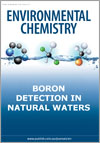EN16196Boron detection and quantification based on the absorption spectra of pyridoxine and its boron complex
Environmental context. Boron, an essential element for human health and the growth of animals and plants, can also be harmful when intake is excessive. Herein, a simple and efficient method for determining boron species in aqueous samples has been developed based on the optical absorption of the pyridoxine or boron–pyridoxine complex. This rapid method is suitable for online analysis, with great significance to drinking water and industrial water treatment.




